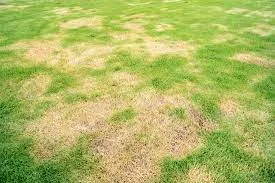Why Is My Grass Turning Brown and Dying?
dying grass - Grass turns brown when roots can no longer absorb nutrients or water from the soil, or when there is insufficient food or water in the soil.
Here are some of the most common factors, and some advice on how to get your lawn to green up again.
Drought/Heat
Many turf grasses become dormant during periods of extreme heat and little water. This is a normal sight; your grass will recover when the temperature lowers and the rain returns. Apply 12 inch of water every two or three weeks throughout the drought to keep a drought-dormant lawn alive. To re-green it, add 1 inch of water every 6 or 7 days — about 2 hours of sprinkler use.
Sprinklers Misadjusted
Check that your sprinklers are hitting all sections of your lawn if it develops brown spots during heat waves. With a little screwdriver, most sprinkler heads may be readily changed. Pulsating sprinklers (also known as impulse sprinklers) are easier to fine-tune than oscillating sprinklers. See here how much Lawn sprinkler system installation cost
Weeds
Common weeds may outcompete your grass for water and nourishment. It's difficult to keep these weeds under control. In the spring, use a pre-emergent pesticide to prevent weed seeds from growing. Alternatively, engage a professional lawn care firm to create a yearly lawn maintenance and treatment plan for you.
Disease
A variety of diseases and fungus can cause your grass to become brown. If your grass is coated in white, black, or brown stuff, you most likely have lawn disease, which should be identified and treated by a lawn professional. Proper lawn care (enough water in the morning, frequent mowing, excellent lawn aeration, and thatch control) will produce a healthy grass that is more resistant to lawn disease.
Cinch Bugs
Drought-loving bugs are like little vampires, sucking plant fluids. Thatch removal and maintaining regular moisture levels are both effective preventive strategies. Insecticides are a last resort since many of them contain harsh chemicals that leach into the watershed and damage beneficial insects. Look for little red, orange, brown, or black bugs (1/32 to 1/5 inch with white markings) if your lawn is wilted.
Grubs
Grubs that feed on grass roots can cause drought damage to your lawn. Allow your grass to dry completely before watering again to control grubs. Grubs prefer Kentucky bluegrass over perennial ryes or perennial grasses. Spreading milky spore powder, a natural creature that suppresses grubs, is another option.
Pet Waste
Animals peeing (urine includes acid) on your lawn cause round areas of dead grass. If you know where your pet likes to go, flush the area with water to dilute the acid.
in the spring and fall will be dry, so make sure to keep your lawn healthy. Don't fertilize when your grass is stressed or during drought. Aerate and inter-seed in fall when weather has cooled and rain is likely. Water in the early morning to combat fungal diseases.

